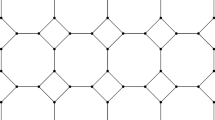The paper considers karyon tilings T of the torus 𝕋d of an arbitrary dimension d. The prototypes of such tilings are the one-dimensional Fibonacci tilings and their two-dimensional counterpart, the Rauzy tilings. Karyon tilings T are important for applications to multidimensional continued fractions. In this paper, local properties of karyon tilings T are considered.
Similar content being viewed by others
References
V. G. Zhuravlev, “Differentiation of induced toric tilings and multidimensional approximations of algebraic numbers,” Zap. Nauchn. Semin. POMI, 445, 33–92 (2016); English transl., J. Math. Sci., 222, 544–584 (2017).
V. G. Zhuravlev, “Two-dimensional approximations by the method of dividing toric tilings,” Zap. Nauchn. Semin. POMI, 440, 81–98 (2015); English transl., J. Math. Sci., 217, No. 1, 54–64 (2016).
V. G. Zhuravlev, “Simplex-karyon algorithm for expansion in multidimensional continued fractions,” Trudy MIAN, 299, 283–303 (2017).
V. G. Zhuravlev, Karyon Continued Fractions [in Russian], VlGU, Vladimir (2019).
V. G. Zhuravlev, “One-dimensional Fibonacci tilings,” Izv. RAN, Ser. Mat., 71, No. 2, 89–122 (2007).
N. N. Manuylov, “The number of hits of points of the sequence {nτg} in the half-open interval,” Chebyshev Sb., 5, No. 3, 72–81 (2004).
G. Rauzy, “Nombres alg´ebriques et substitutions,” Bull. Soc. Math. France, 110, 147–178 (1982).
V. G. Zhuravlev, “Rauzy tilings and bounded remainder sets on the torus,” Zap. Nauchn. Semin. POMI, 322, 83–106 (2005); English transl., J. Math. Sci., 137, No. 2, 4658–4672 (2006).
V. G. Zhuravlev, “Parametrization of the two-dimensional quasiperiodic Rauzy tiling,” Algebra Anal., 22, No. 4, 21–56 (2010).
V. G. Zhuravlev, “Exchanged toric developments and bounded remainder sets,” Zap. Nauchn. Semin. POMI, 392, 95–145 (2011); English transl., J. Math. Sci., 184, 716–745 (2012).
V. G. Zhuravlev, “Bounded remainder polyhedra,” Sovrem. Probl. Mat. (MIAN), 16, 82–102 (2012).
V. G. Zhuravlev, “Simplex-module algorithm for expansion of algebraic numbers in multidimensional continued fractions,” Zap. Nauchn. Semin. POMI, 449, 168–195 (2016); English transl., J. Math. Sci., 225, 924–949 (2017).
E. S. Fedorov, The Elements of Configurations [in Russian], Moscow (1953).
G. F. Voronoi, Collected Works, Vol. 2., Kiev (1952).
V. G. Zhuravlev, “On additive property of a complexity function related to Rauzy tiling,” in: Analytic and Probabilistic Methods in Number Theory, E. Manstavicius et al. (Eds), TEV, Vilnius (2007), pp. 240–254.
V. G. Zhuravlev, “A local algorithm for constructing derived tilings of the two-dimensional torus,” Zap. Nauchn. Semin. POMI, 479, 85–120 (2019); English transl., J. Math. Sci., 249, No. 1, 54–78 (2020).
A. V. Shutov, A. V. Maleev, and V. G. Zhuravlev, “Complex quasiperiodic self-similar tilings: their parameterization, boundaries, complexity, growth and symmetry,” Acta Crystallogr., A66, 427–437 (2010).
Author information
Authors and Affiliations
Corresponding author
Additional information
Translated from Zapiski Nauchnykh Seminarov POMI, Vol. 502, 2021, pp. 32–73.
Rights and permissions
About this article
Cite this article
Zhuravlev, V.G. Local Structure of Karyon Tilings. J Math Sci 264, 122–149 (2022). https://doi.org/10.1007/s10958-022-05984-9
Received:
Published:
Issue Date:
DOI: https://doi.org/10.1007/s10958-022-05984-9



